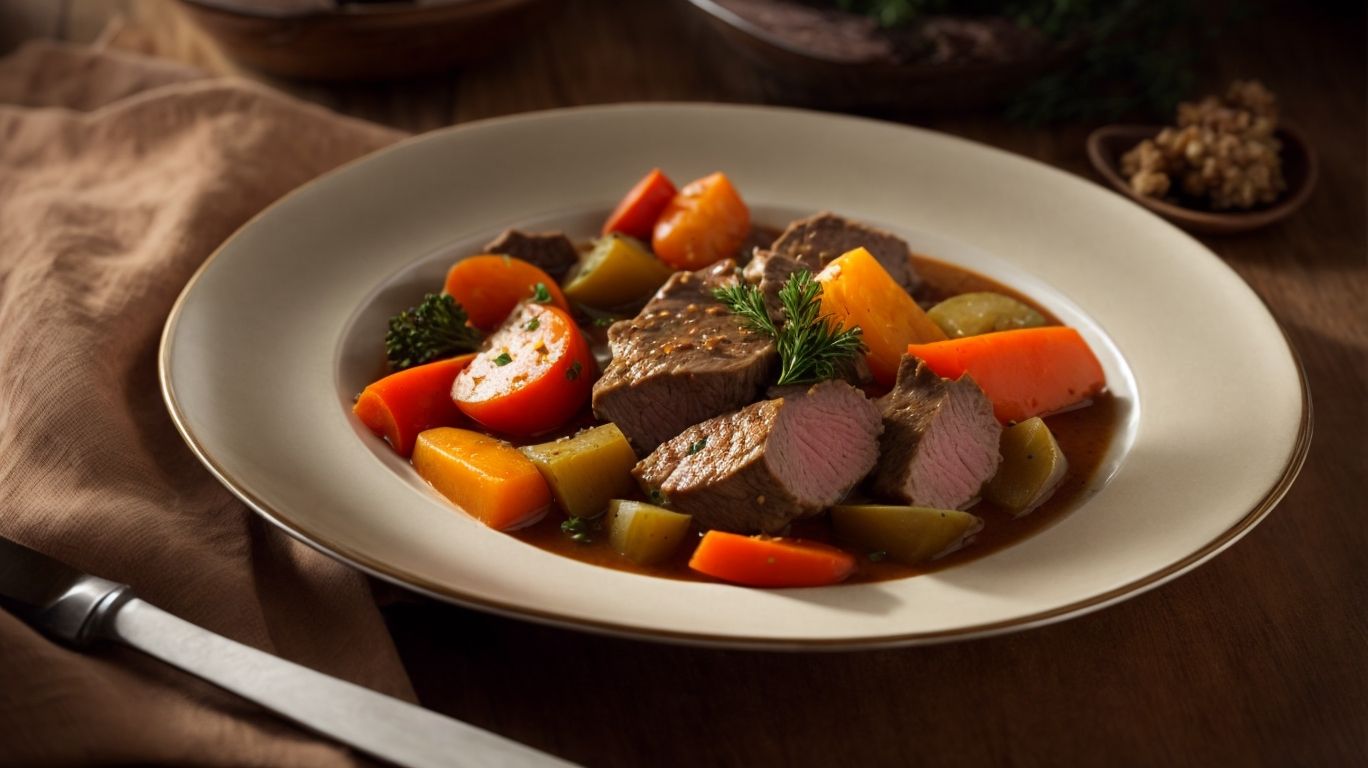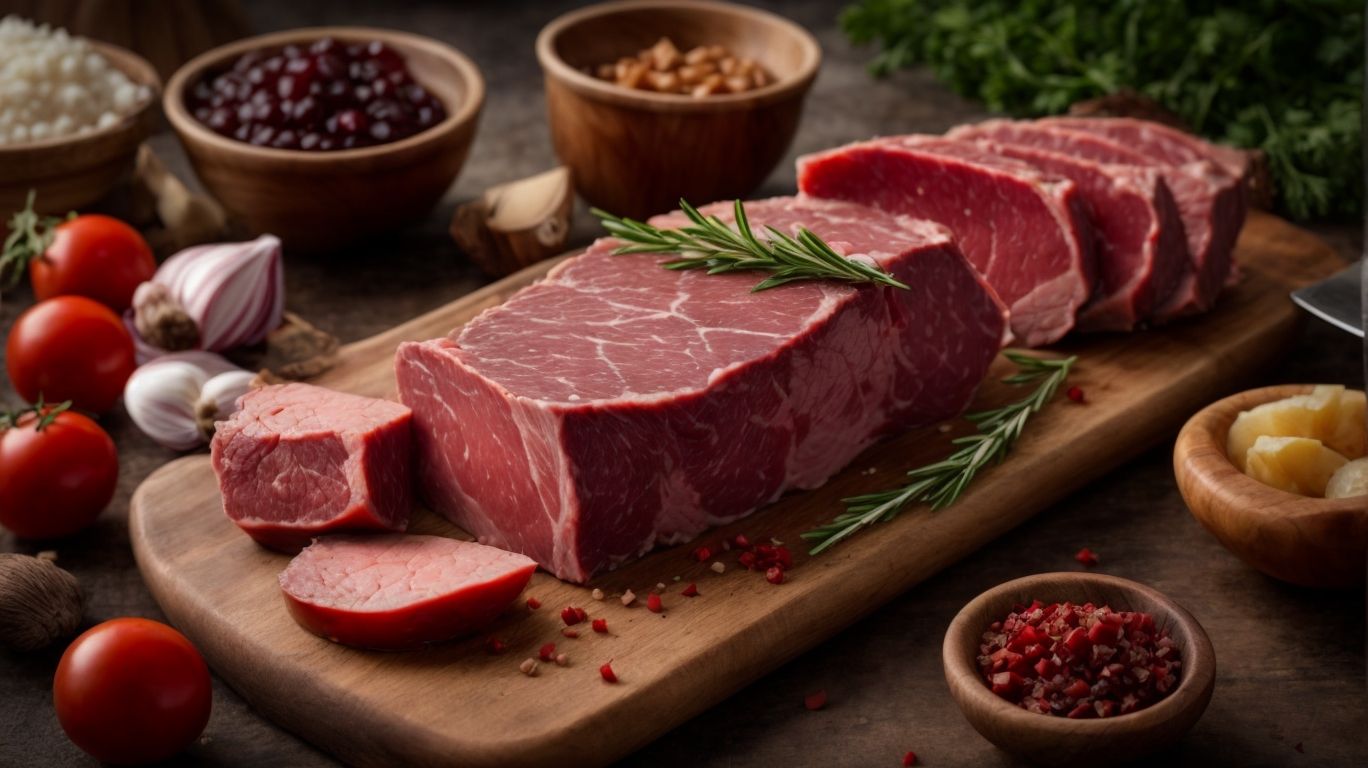How to Cook Stew Meat by Itself?
Are you looking to elevate your cooking game with some delicious stew meat recipes?
We explore everything you need to know about stew meat – from what it is and why you should cook it by itself, to how to choose the right cuts of meat and prepare them for cooking.
We also discuss the best cooking methods, seasonings, and tips for serving and storing stew meat. Get ready to impress your family and friends with some mouth-watering dishes!
Key Takeaways:
What is Stew Meat?
Stew meat refers to meat that is suitable for slow cooking to achieve a tender and flavorful result. Typically, stew meat comes from cuts like beef round that contain connective tissues, perfect for simmering to break down the meat fibers.
This slow cooking process allows the connective tissues to break down, releasing gelatin that adds richness and depth to the stew. The collagen in the connective tissues converts to gelatin during simmering, resulting in a velvety texture and complex flavor profile. Stew meat is ideal for creating hearty dishes like beef bourguignon or lamb stew, where the long cooking time enhances the tenderness and melds the flavors seamlessly. Choosing the right type of stew meat, such as chuck or brisket, ensures a succulent and satisfying meal.
Why Cook Stew Meat by Itself?
Cooking stew meat by itself ensures that the flavors and textures of the meat are preserved and enhanced, resulting in a hearty meal that is both easy to prepare and bursting with flavor.
Slow-cooking stew meat allows the tough fibers to break down gradually, transforming them into tender, melt-in-your-mouth deliciousness. This method not only intensifies the taste but also infuses the meat with rich, savory notes as it simmers gently in its own juices.
The simplicity of preparing stew meat means you can effortlessly create a wholesome meal without spending hours in the kitchen. Plus, the versatility of stew meat allows you to experiment with various seasonings and ingredients to tailor the dish to your taste preferences.
How to Choose the Right Stew Meat?
Selecting the right stew meat is crucial to achieving a delicious outcome. When choosing stew meat, factors to consider include the quality of beef chuck, the flavor profile of beef stock, and the aromatic blend of oregano, onions, peppers, and garlic.
What Cuts of Meat are Best for Stew?
The best cuts of meat for stew include beef short ribs, flavorful lamb shoulder, tender beef chuck, and meaty beef round, all of which offer unique textures and flavors when slow-cooked to perfection.
Beef short ribs are known for their rich, marbled meat that becomes succulent and tender after being simmered in a savory stew, adding a depth of flavor to the dish.
- Lamb shoulder, with its slightly gamey taste, brings a robust flavor profile to the stew, ideal for those who enjoy a more pronounced meaty taste.
- Beef chuck, often referred to as blade steak, is a budget-friendly option that becomes melt-in-your-mouth tender when braised in a stew, creating a hearty and satisfying meal.
- Beef round, a leaner cut, offers a firmer texture that holds up well during long cooking times, making it a great choice for those who prefer a leaner stew.
How to Pick Quality Stew Meat?
Selecting quality stew meat involves choosing grass-fed beef rich in Omega-3s for enhanced nutritional benefits and tender connective tissues that ensure the meat maintains its tenderness throughout the slow-cooking process.
Grass-fed beef is known for its higher levels of Omega-3 fatty acids compared to conventionally raised beef, offering a healthier option for consumers concerned about their diet. Omega-3s are essential fatty acids that support heart health and brain function.
Regarding stew meat, the presence of connective tissues like collagen and elastin in the beef is crucial. These tissues break down during cooking, resulting in that melt-in-your-mouth texture and rich, flavorful broth that sets a quality stew apart.
Preparing Stew Meat for Cooking
Before cooking stew meat, it is essential to prepare it properly to ensure tender and flavorful results. This includes techniques like marinating with coconut aminos or following specific dietary requirements like the Autoimmune Protocol (AIP) or Vitamin A Deficiency (VAD) diet.
How to Cut Stew Meat into Bite-sized Pieces?
Achieving the perfect bite-sized pieces of stew meat requires precision in cutting beef chunks to ensure even cooking and optimal tenderness. Improving knife skills can enhance the cooking experience and the final presentation of the dish.
When preparing stew, the size and shape of the beef chunks greatly influence the cooking process. Consistent cuts allow the meat to cook uniformly, preventing some pieces from becoming tough while others stay tender. To achieve this consistency, it’s recommended to use a sharp knife and a steady hand. By mastering knife skills, you not only streamline the cooking process but also elevate the aesthetics of the dish. Cutting beef into uniform pieces also promotes a visually appealing presentation, making each spoonful a delightful experience.
Should You Marinate Stew Meat?
Marinating stew meat can enhance its flavors, tenderize the meat, and infuse it with a delicious blend of spices. The marinating process adds depth to the dish and creates a more complex taste profile.
The process of marinating stew meat is not just about adding flavor; it also plays a crucial role in breaking down the tough fibers of the meat, resulting in a more tender and juicy texture. Spices are the heart of any marinade, offering a plethora of benefits beyond taste. For example, garlic and onion can add depth, while paprika and cumin bring a smoky richness.
What Spices and Seasonings Work Best with Stew Meat?
Selecting the right spices and seasonings is crucial for enhancing the flavors of stew meat. Ingredients like sea salt, aromatic Mexican spices, and earthy cumin can elevate the taste profile of the dish.
Sea salt, with its pure and clean flavor, acts as a fundamental element in bringing out the natural taste of the meat without overpowering it.
Regarding Mexican spices like cumin, they add a warm and slightly smoky essence that pairs excellently with the richness of the stew.
Combining these spices not only adds layers of complexity but also creates a harmonious blend of flavors that dance on your taste buds with each spoonful.
Cooking Stew Meat by Itself
Cooking stew meat by itself requires selecting appropriate methods such as simmering or using kitchen appliances like the Instant Pot or pressure cooker for efficient and flavorful results. The cooking method significantly impacts the tenderness and taste of the stew meat.
What Cooking Methods are Suitable for Stew Meat?
Cooking methods like pan-frying can add a touch of crispiness to stew meat, creating delicious caramelized edges. Using quality cookware like All Clad and maintaining low heat are essential for achieving the perfect texture and flavors.
When pan-frying stew meat, ensure that the cookware is preheated adequately to sear the meat properly. The sizzle that ensues upon contact is a good indicator of the right temperature. Remember to regulate the heat throughout the cooking process to prevent burning or undercooking.
Add a drizzle of oil to the pan before placing the meat to enhance browning and prevent sticking. For an extra depth of flavor, consider seasoning the meat with herbs and spices before searing.
Allow the meat to develop a golden crust on each side before turning, ensuring a juicy interior and a flavorful exterior.
How Long Does it Take to Cook Stew Meat?
The cooking time for stew meat varies depending on the method used, with simmering typically required to achieve tender and flavorful results. Patience during the cooking process is key to crafting a hearty meal with perfectly cooked stew meat.
When simmering stew meat, it is crucial to allow enough time for the tough cuts of meat to break down and become melt-in-your-mouth tender.
The slow cooking process not only softens the meat but also allows the flavors of the ingredients to meld together, creating a rich and aromatic dish.
Depending on the type of meat and size of the cubes, simmering can take anywhere from 1.5 to 3 hours to reach that desired level of tenderness and depth of flavor.
What are Some Tips for Cooking Tender Stew Meat?
To ensure tender stew meat, consider seasoning with sea salt, incorporating aromatic spices, and experimenting with ingredients like coconut aminos for flavor. Adapting to dietary requirements such as AIP or VAD can also influence the cooking process.
Regarding seasoning stew meat, the combination of sea salt and spices not only enhances the taste but also helps tenderize the meat during the cooking process. Opt for high-quality sea salt to bring out the natural flavors of the ingredients.
Coconut aminos can add a unique touch to your stew, offering a slightly sweet and umami-rich flavor profile. This ingredient is both gluten-free and soy-free, making it a versatile option for various dietary preferences.
For those following an AIP or VAD diet, consider making adjustments by omitting certain spices or using alternative aromatics to suit your specific culinary requirements while maintaining a delicious final dish.
Serving and Storing Stew Meat

Credits: Poormet.Com – Arthur Ramirez
After preparing delicious stew meat, it’s essential to serve it with complementary sides and store any leftovers properly for future enjoyment. Knowing how to freeze and reheat stew meat ensures that every meal is as delightful as the first.
How to Serve Stew Meat?
Serving stew meat involves presenting it as a hearty and satisfying meal, accompanied by side dishes that complement the flavors of the dish. Garnishing with additional spices or herbs can enhance the visual appeal and taste of the meal.
When serving stew meat, consider pairing it with a fluffy bed of mashed potatoes or a mound of buttery rice to soak up the rich sauces. Roasted vegetables, such as carrots, parsnips, or Brussels sprouts, can add a burst of color and nutrients to the plate. For a touch of freshness, a simple salad with a tangy vinaigrette can balance the richness of the stew. A crusty artisan bread or warm dinner rolls are perfect for sopping up any remaining juices and adding a satisfying crunch to your meal.
Can You Freeze Stew Meat?
Freezing stew meat is a convenient way to extend its longevity and preserve its flavors for future consumption.
It not only allows you to have pre-prepped ingredients at hand, but it also locks in the rich taste of the meat for a later, more flavorful meal.
When freezing stew meat, it’s crucial to follow the correct procedures to ensure the texture and flavor remain intact.
By properly freezing stew meat, you can enjoy the convenience of a ready-to-cook meal while still savoring the delectable taste of freshly prepared stew.
How to Reheat Stew Meat?
Reheating stew meat can be done using various methods like the oven or microwave, depending on personal preferences and time constraints. Proper reheating ensures that the flavors are revitalized, and the meat remains tender.
When reheating stew meat in the oven, preheat it to around 350 degrees Fahrenheit to maintain the dish’s flavors. Place the stew meat in an oven-safe dish, cover it with foil to prevent drying out, and let it heat for about 20-30 minutes, or until thoroughly warmed.
Alternatively, for a quick solution, reheating stew meat in the microwave can be efficient; transfer the meat to a microwave-safe dish, cover it loosely, and heat in intervals, stirring occasionally to ensure even heating. Remember, following the right reheating method keeps the stew meat from becoming tough and preserves its original taste.
Frequently Asked Questions
How to Cook Stew Meat by Itself?
1. What type of meat is best for cooking stew by itself?
For stew meat, it’s best to use tougher cuts of beef such as chuck, round, or brisket. These cuts have more connective tissue, which breaks down during the cooking process, resulting in tender and flavorful meat.
2. How long should I cook stew meat by itself?
The cooking time for stew meat can vary depending on the cut of meat, but on average it takes around 2-3 hours to cook. This allows enough time for the connective tissue to break down and for the meat to become tender.
3. What is the best method for cooking stew meat?
The best method for cooking stew meat is to braise it. This involves browning the meat in a hot pan, then adding liquid and cooking it on low heat for an extended period of time. This ensures that the meat cooks slowly and becomes tender.
4. Can I cook stew meat without browning it first?
While browning the meat adds flavor and texture to the stew, it is not necessary. If you’re short on time, you can skip this step and simply add the meat to the pot with the other ingredients.
5. How can I make my stew meat more tender?
To make your stew meat more tender, you can marinate it in a mixture of vinegar, oil, and herbs for a few hours before cooking. This helps to break down the connective tissue and results in a more tender and flavorful meat.
6. Can I cook stew meat in a slow cooker?
Yes, you can cook stew meat in a slow cooker. The low and slow cooking method is perfect for stew meat, and it allows for easy meal prep. Simply add all the ingredients to the slow cooker and let it cook for 6-8 hours on low or 3-4 hours on high.





